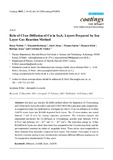| dc.contributor.author | Wafula, Henry | |
| dc.contributor.author | Robinson, Musembi | |
| dc.contributor.author | Juma, Albert | |
| dc.contributor.author | Sakwa, Thomas | |
| dc.contributor.author | e Kitui, Manass | |
| dc.contributor.author | Araoz, Rodrigo | |
| dc.contributor.author | Fischer, Christian-H. | |
| dc.date.accessioned | 2023-07-06T11:22:47Z | |
| dc.date.available | 2023-07-06T11:22:47Z | |
| dc.date.issued | 2015-02-15 | |
| dc.identifier.uri | https://doi.org/10.3390/coatings5010054 | |
| dc.identifier.uri | https://www.mdpi.com/2079-6412/5/1/54 | |
| dc.identifier.uri | http://ir-library.mmust.ac.ke:8080/xmlui/handle/123456789/2257 | |
| dc.description.abstract | Ion layer gas reaction (ILGAR) method allows for deposition of Cl-containing and Cl-free In2S3 layers from InCl3 and In(OCCH3CHOCCH3)3 precursor salts, respectively. A comparative study was performed to investigate the role of Cl on the diffusion of Cu from CuSCN source layer into ILGAR deposited In2S3 layers. The Cl concentration was varied between 7 and 14 at.% by varying deposition parameters. The activation energies and exponential pre-factors for Cu diffusion in Cl-containing samples were between 0.70 to 0.78 eV and between 6.0 × 10−6 and 3.2 × 10−5 cm2/s. The activation energy in Cl-free ILGAR In2S3 layers was about three times less compared to the Cl-containing In2S3, and the pre-exponential constant six orders of magnitude lower. These values were comparable to those obtained from thermally evaporated In2S3 layers. The residual Cl-occupies S sites in the In2S3 structure leading to non-stoichiometry and hence different diffusion mechanism for Cu compared to stoichiometric Cl-free layers. | en_US |
| dc.language.iso | en | en_US |
| dc.publisher | coatings | en_US |
| dc.subject | Role of Cl on Diffusion of Cu in In2S3 Layers Prepared by Ion Layer Gas Reaction Method | en_US |
| dc.title | Role of Cl on Diffusion of Cu in In2S3 Layers Prepared by Ion Layer Gas Reaction Method | en_US |
| dc.type | Article | en_US |

